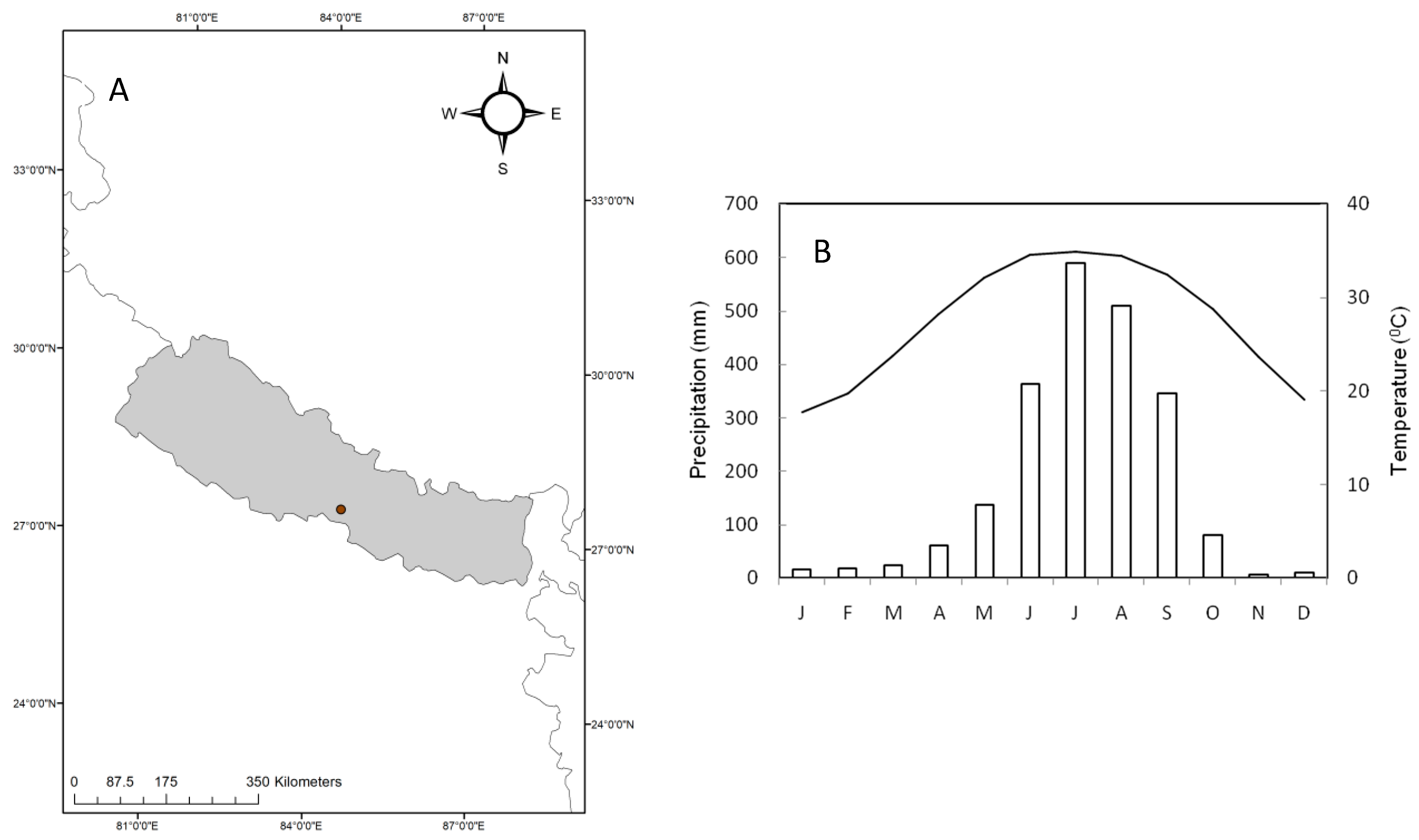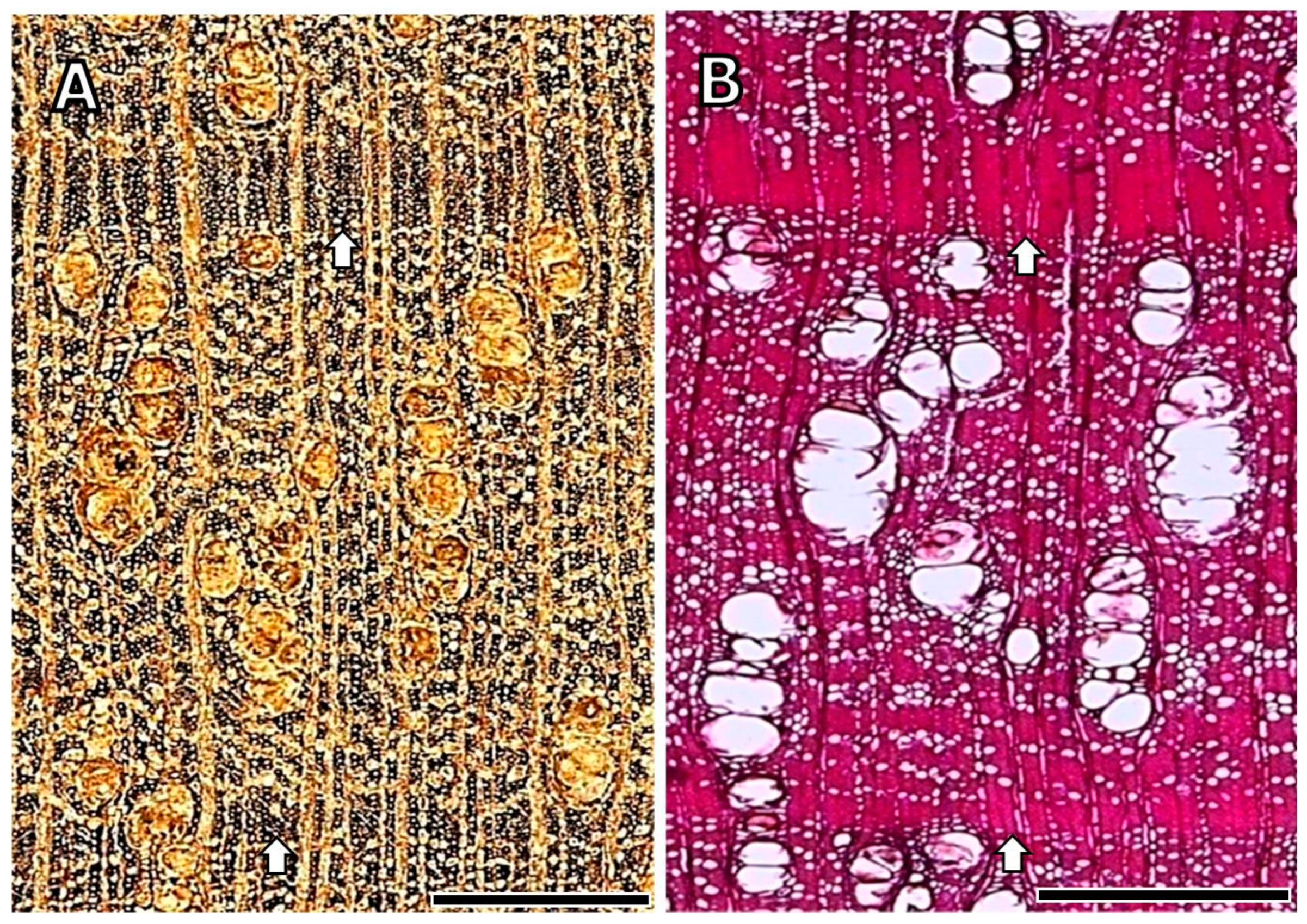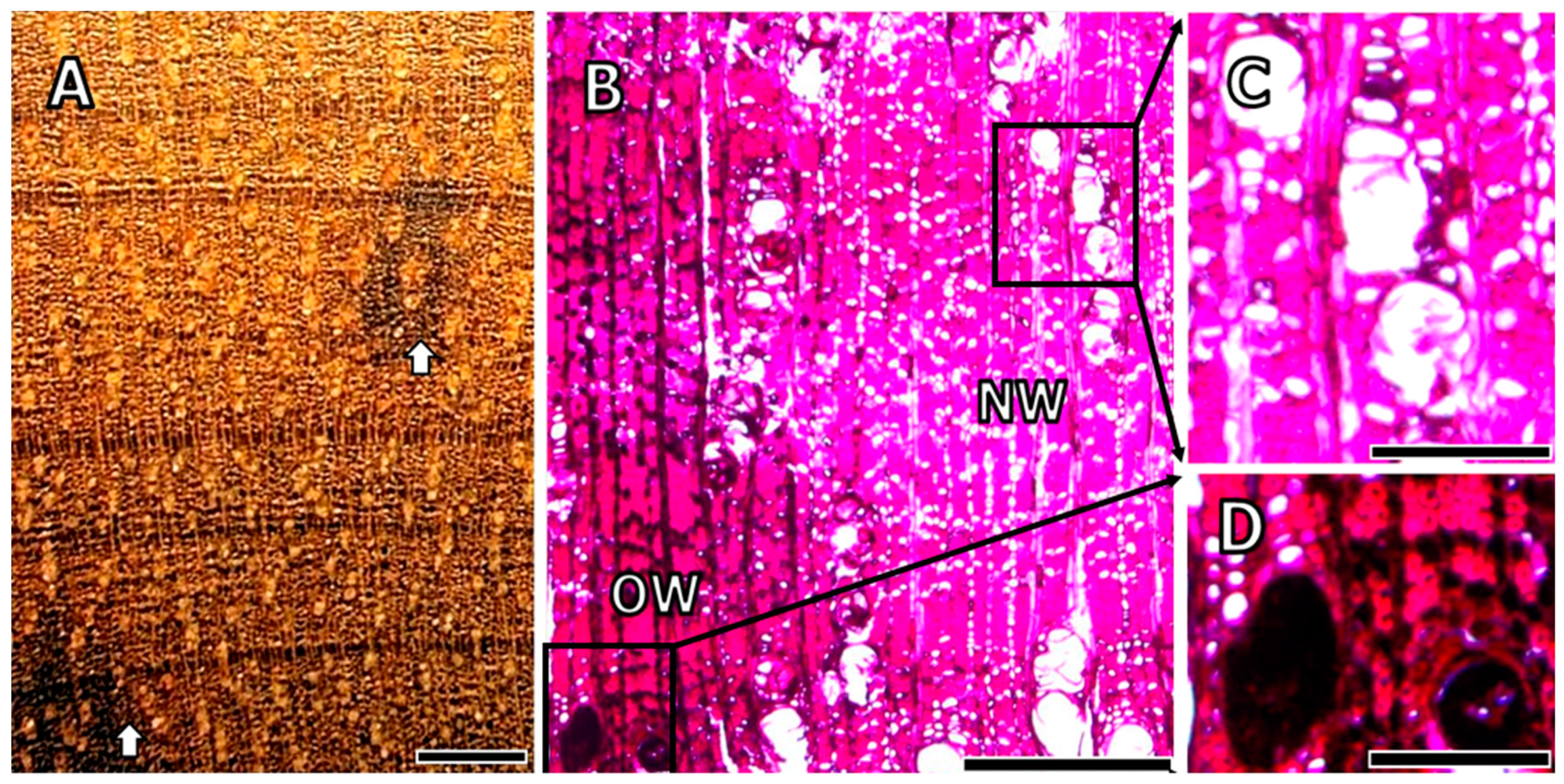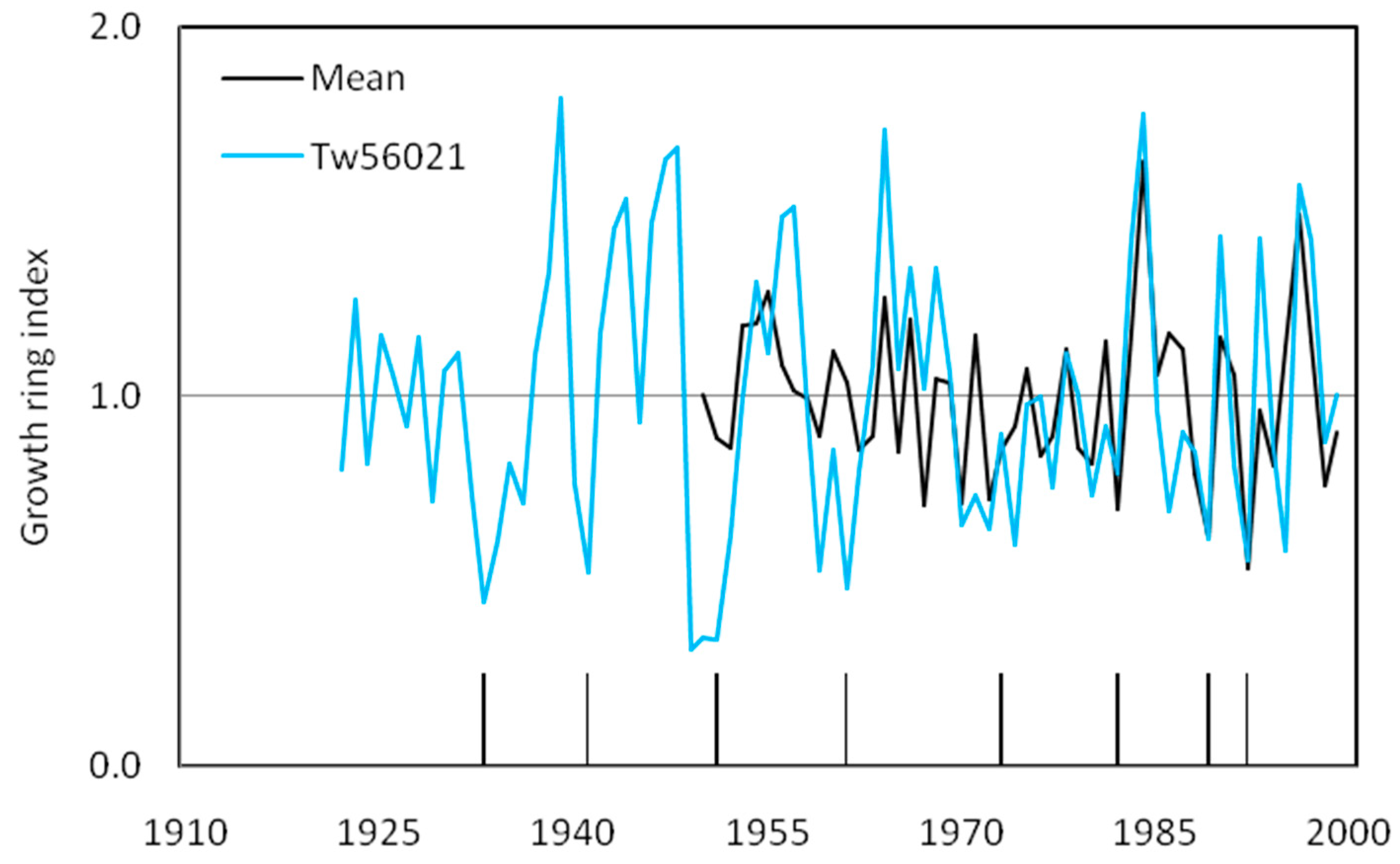Growth-Ring Analysis of Diploknema butyracea Is a Potential Tool for Revealing Indigenous Land Use History in the Lower Himalayan Foothills of Nepal
Abstract
1. Introduction
2. Materials and Methods
2.1. Sample Origin and Study Area
2.2. Sample Preparation and Anatomical Observations
2.3. Growth-Ring Analysis
3. Results
3.1. Anatomy of Growth Ring and Fire Trace
3.2. Growth-ring Analysis
4. Discussion
4.1. Growth-Ring Structure and Periodicity
4.2. Fire Traces
5. Conclusions and Perspectives
Supplementary Materials
Author Contributions
Funding
Acknowledgments
Conflicts of Interest
References
- Heinimann, A.; Mertz, O.; Frolking, S.; Egelund, A.C.; Hurni, K.; Sedano, F.; Chini, L.P.; Sahajpal, R.; Hansen, M.; Hurtt, G. A global view of shifting cultivation: Recent, current, and future extent. PLoS ONE 2017, 12, e0184479. [Google Scholar] [CrossRef]
- UN. State of World’s Indigenous People; Doc.ST/ESA/328; United Nations: NewYork, NY, USA, 2009. [Google Scholar]
- Dhakal, S. Anthropological perspective on shifting cultivation: A Case study of Khoriya Cultivation in Arun Valley of Eastern Nepal. Occas. Pap. Sociol. Anthr. 2000, 6, 92–111. [Google Scholar] [CrossRef]
- Kerkhoff, E.; Sharma, E. Debating Shifting Cultivation in the Eastern Himalayas: Farmer’s Innovations as Lessons for Policy; International Centre for Integrated Mountain Development (ICIMOD): Kathmandu, Nepal, 2006. [Google Scholar]
- Piya, L.; Maharjan, K.L.; Joshi, N.P.; Dangol, D.R. Collection and marketing of non-timber forest products by Chepang community in Nepal. J. Agric. Environ. 2011, 12, 10–21. [Google Scholar] [CrossRef]
- Sharma, D.P. Understanding the Chepangs and Shifting Cultivation: A Case Study from Rural Village of Central Nepal. Dhaulagiri J. Sociol. Anthr. 2011, 5, 247–262. [Google Scholar] [CrossRef]
- Minnich, R.A.; Barbour, M.G.; Burk, J.H.; Sosa-Ramirez, J. California mixed-conifer forests under unmanaged fire regimes in the Sierra San Pedro Martir, Baja California, Mexico. J. Biogeogr. 2000, 27, 105–129. [Google Scholar] [CrossRef]
- Oddi, F.J.; Ghermandi, L. Dendroecological potential of shrubs for reconstructing fire history at landscape scale in Mediterranean-type climate grasslands: The case of Fabiana imbricata. Dendrochronologia 2015, 33, 16–24. [Google Scholar] [CrossRef]
- Li, P.; Feng, Z. Extent and Area of Swidden in Montane Mainland Southeast Asia: Estimation by Multi-Step Thresholds with Landsat-8 OLI Data. Remote Sens. 2016, 8, 44. [Google Scholar] [CrossRef]
- Matin, M.A.; Chitale, V.S.; Murthy, M.S.R.; Uddin, K.; Bajracharya, B.; Pradhan, S. Understanding forest fire patterns and risk in Nepal using remote sensing, geographic information system and historical fire data. Int. J. Wild land Fire 2017, 26, 276–286. [Google Scholar] [CrossRef]
- Fujisaka, S.; Hurtado, L.; Uribe, R. A working classification of slash-and-burn agricultural systems. Agrofor. Syst. 1996, 34, 151–169. [Google Scholar] [CrossRef]
- Acharya, K.P.; Dangi, R.B.; Acharya, M. Understanding forest degradation in Nepal. Unasylva 2011, 62, 238. Available online: www.fao.org/docrep/015/i2560e/i2560e06.pdf (accessed on 25 March 2019).
- Giglio, L. MODIS Collection 4 Active Fire Product User’s Guide. Version 2.3; University of Maryland, Department of Geography: College Park, MD, USA, 2007; Available online: http://maps.geog.umd.edu/firms/default.asp (accessed on 2 May 2015).
- Takahata, C.; Amin, R.; Sarma, P.; Banarjee, G.; Oliver, W.; Fa, J.E. Remotely-sensed active fire data for protected area management: Eight-year patterns in the Manas National Park, India. Environ. Manag. 2010, 45, 414–423. [Google Scholar] [CrossRef] [PubMed]
- Fritts, H.C.; Swetnam, T.W. Dendroecology: A tool for evaluating variations in past and present forest environments. Adv. Ecol. Res. 1989, 19, 111–189. [Google Scholar]
- Lombardo, K.J.; Swetnam, T.W.; Baisan, C.H.; Borchert, M.I. Using Bigcone Douglas-fir fire scars and tree rings to reconstruct interior Chaparral fire history. Fire Ecol. 2009, 5, 35–56. [Google Scholar] [CrossRef]
- Fournier, T.P.; Battipaglia, G.; Brossier, B.; Carcailleta, C. Fire-scars and polymodal age-structure provide evidence of fire-events in an Aleppo pine population in southern France. Dendrochronologia 2013, 31, 159–164. [Google Scholar] [CrossRef]
- Sidorova, M.O.; Büntgen, U.; Omurova, G.T.; Kardash, O.V.; Myglan, V.S. First dendro-archaeological evidence of a completely excavated medieval settlement in the extreme north of Western Siberia. Dendrochronologia 2017, 44, 146–152. [Google Scholar] [CrossRef]
- McBrdie, J.R. An analysis of tree rings and fire scars to establish fire history. Tree-Ring Bull. 1983, 43, 51–67. [Google Scholar]
- Smith, K.T.; Sutherland, E.K. Fire-scar formation and compartmentalization in Oak. Can. J. Res. 1999, 29, 166–171. [Google Scholar] [CrossRef]
- Schweingruber, F.H. Tree Rings and Environment: Dendroecology; Paul Haupt Publishers: Bern, Switzerland, 2007. [Google Scholar]
- Bigio, E.; Gärtner, H.; Conedera, M. Fire-related features of wood anatomy in a Sweet Chestnut (Castanea sativa) coppice in southern Switzerland. Trees 2012, 24, 643–655. [Google Scholar] [CrossRef]
- Smith, A.M.; Sparks, A.M.; Kolden, C.A.; Abatzoglou, J.T.; Talhelm, A.F.; Johnson, D.M.; Boschetti, L.; Lutz, J.A.; Apostol, K.G.; Yedinak, K.M. Towards a new paradigm in fire severity research using dose–response experiments. Int. J. Wild land Fire 2016, 25, 158–166. [Google Scholar] [CrossRef]
- Stambaugh, M.C.; Smith, K.T.; Dey, D.C. Fire scar growth and closure rates in white oak (Quercus alba) and the implications for prescribed burning. Ecol. Manag. 2017, 391, 396–403. [Google Scholar] [CrossRef]
- Kaye, M.W.; Swetnam, T.W. An assessment of fire, climate, and Apache history in the Sacramen to Mountains, New Mexico. Physic. Geogr. 1999, 20, 305–330. [Google Scholar] [CrossRef]
- Taylor, A.H.; Trouet, V.; Skinner, C.N. Climatic influences on fire regimes in montane forests of the southern Cascades. Int. J. Wild land Fire 2008, 17, 60–71. [Google Scholar] [CrossRef]
- Conedera, M.; Tinner, W.; Neff, C.; Meurer, M.; Dickens, A.F.; Krebs, P. Reconstructing past fire regimes: Methods, applications, and relevance to fire management and conservation. Quart. Sci. Rev. 2009, 28, 435–456. [Google Scholar] [CrossRef]
- Hessel, A.E.; Ariya, U.; Brown, P.; Byambasuren, O.; Green, T.; Jacoby, G.; Sutherland, E.K.; Nachin, B.; Maxwell, R.S.; Pederson, P.; et al. Reconstructing fire history in Central Mongolia from tree-rings. Int. J. Wild land Fire 2012, 81, 86–92. [Google Scholar] [CrossRef]
- Harley, G.L.; Baisan, C.H.; Brown, P.M.; Grissino-Mayer, H.D.; Falk, D.A.; Flatley, W.T.; Hessl, A.; Heyerdahl, E.K.; Kaye, M.W.; Lafon, C.W.; et al. Advancing Dendrochronological Studies of Fire in the United States. Fire 2018, 1, 11. [Google Scholar] [CrossRef]
- Danzer, S.R.; Baisan, C.H.; Swetnam, T.W. The Influence of Fire and Land-Use History on Stand Dynamics in the Huachuca Mountains of the Southeastern Arizona. In Effects of Fire on Madrean Province Ecosystems: A Symposium; Ffolliott, P.F., DeBano, L.F., Baker, M.B., Gottfried, G.J., Solis-Garza, G., Edminster, C.B., Neary, D.G., Hamre, R.H., Eds.; USDA Forest Service, Rocky Mountain Forest and Range Experiment Station, Fort Collins: Collorado, CO, USA, 1996; pp. 265–270. [Google Scholar]
- Harley, G.L.; Grissino-Mayer, H.D.; Horn, S.P. Fire history and forest structure of an endangered subtropical ecosystem in the Florida Keys, USA. Int. J. Wildl Fire 2013, 22, 394–404. [Google Scholar] [CrossRef]
- Syampungani, S.; Geledenhuys, C.; Chirwa, P.W. Age and growth rate determination using growth rings of selected miombo woodland species in charcoal and, slash-and-burn re-growth stands in Zambia. J. Ecol. Nat. Environ. 2010, 2, 167–174. [Google Scholar]
- Cassell, B.A.; Alvarado, E. Reconstruction of fire history in Mexican tropical pines using tree rings. For. Chronext 2012, 88, 553–555. [Google Scholar] [CrossRef][Green Version]
- Bhattacharyya, A.; LaMarche, V.C., Jr.; Hughes, M.K. Tree-ring chronologies from Nepal. Tree-Ring Bull. 1992, 52, 59–66. [Google Scholar]
- Cook, E.R.; Krusic, P.J.; Jones, P.D. Dendroclimatic signals in long tree-ring chronologies from the Himalayas of Nepal. Int. J. Clim. 2003, 23, 707–732. [Google Scholar] [CrossRef]
- Sano, M.; Furuta, F.; Kobayashi, O.; Sweda, T. Temperature variations since the mid-18th century for western Nepal, as reconstructed from tree-ring width and density of Abies spectabilis. Dendrochronologia 2005, 23, 83–92. [Google Scholar] [CrossRef]
- Chhetri, P.K.; Shrestha, K.B. Dendrochronology and climate change study in Nepal: A preview. Banko Janakari 2009, 19, 42–43. [Google Scholar] [CrossRef][Green Version]
- Shrestha, K.B.; Hofgaard, A.; Vandvik, V. Tree-growth response to climatic variability in two climatically contrasting tree line ecotone areas, Central Himalaya, Nepal. Can. J. For. Res. 2015, 45, 1643–1653. [Google Scholar] [CrossRef]
- Schmidt, B. Dendrochronological research in south Mustang. Anc. Nepal. 1993, 130–131, 20–25. [Google Scholar]
- Schmidt, B.; Wazny, T.; Malla, K.; Hofs, E.; Khalessi, M. Chronologies for Historical Dating in High Asia/Nepal. In Tree Ring Analysis: Biological, Methodological and Environmental Aspects; Wimmer, R., Vetter, R.E., Eds.; CABI International: Wallingford, UK, 1999; pp. 205–211. [Google Scholar]
- Bhuju, D.R.; Carrer, M.; Gaire, N.P.; Soraruf, L.; Riondato, R.; Salerno, F.; Maharjan, S.R. Dendroecological study of high altitude forest at Sagarmatha National Park, Nepal. In Contemporary Research in Sagarmatha (Mt. Everest) Region, Nepal; Jha, P.K., Khanal, I.P., Eds.; Nepal Academy of Science and Technology: Lalitpur, Nepal, 2010; pp. 119–130. [Google Scholar]
- Suwal, M.K. Tree Species Line Advance of Abies spectabilis in Manaslu Conservation Area, Nepal Himalaya. Master’s Thesis, Central Department of Botany, Tribhuvan University, Kathmandu, Nepal, 2010. [Google Scholar]
- Gaire, N.P.; Dhakal, Y.R.; Lekhak, H.C.; Bhuju, D.R.; Shah, S.K. Dynamics of Abies spectabilis in relation to climate change at the tree line ecotone in Langtang National Park, Nepal. J. Sci. Technol. 2011, 12, 220–229. [Google Scholar]
- Gaire, N.P.; Koirala, M.; Bhuju, D.R.; Borgaonkar, H.P. Tree line dynamics with climate change at Central Nepal Himalaya. Clim. Past Discuss. 2013, 9, 5941–5976. [Google Scholar] [CrossRef]
- Majumdar, K.; Datta, B.K.; Shankar, U. Establishing continuity in distribution of Diploknema butyracea (Roxb.) H. J. Lam in Indian subcontinent. J. Res. Biol. 2012, 2, 660–666. [Google Scholar]
- Sundriyal, M.; Sundriyal, R.C. Structure, phenology, fruit yield, and future prospects of some prominent wild edible plant species of the Sikkim Himalaya, India. J. Ethnobiol. 2004, 24, 113–138. [Google Scholar]
- Beeckman, H.; Bhattarai, T.R.; Adhihari, D.; Dahal, P.; Mijnsbrugge, K.V. Knowledge Generationon Tropical Forest Products: A Model from Nepal. In Proceedings of the International Symposium on Tropical Forests in a Changing Global Context, Brussels, Belgium, 8–9 November 2004; DeDapper, M., Ed.; UNESCO and Belgian Federal Science Policy Office: Brussels, Belgium, 2005; pp. 293–305. [Google Scholar]
- Yadav, R.P.; Bisht, J.K. Agroforestry: Away to conserve MPTs in North Western Himalaya. Res. J. Agric. Sci. 2013, 1, 8–13. [Google Scholar]
- Paudel, S.; Wiersum, K.F. Tenure arrangements and management intensity of Butter tree (Diploknema butyracea) in Makawanpur district, Nepal. Int. Rev. 2002, 4, 223–230. [Google Scholar] [CrossRef]
- Shakya, M.R. Chepangs and Chiuri—The use of non-timber forest products in Nepal. Intermed. Technol. Food Chain 2000, 26, 3–25. [Google Scholar]
- Joshi, N.C.; Chaudhary, A.; Rawat, G.S. Cheura (Diploknema butyracea) as a livelihood option for forest-dweller tribe (Van-Raji) of Pithoragarh, Uttarakhand, India. Int. J. Environ. Rehabilita. Conser. 2018, 9, 134–141. [Google Scholar] [CrossRef]
- Pandit, B.H. Non-timber forest products on shiftingcultivation plots (Khorya): A means of improving livelihood of Chepang Rural Hill Tribe of Nepal. Asia-Pac. J. Rural Dev. 2001, 11, 1–14. [Google Scholar] [CrossRef]
- Gurung, G.M. Economic Modernization in a Chepang village in Nepal. Occas. Pap. Sociol. Anthr. 1990, 2, 33–39. [Google Scholar] [CrossRef]
- Trouet, V.; Van Oldenborgh, G.J. KNMI Climate Explorer: A web-based research tool for high-resolution paleoclimatology. Tree-Ring Res. 2013, 69, 3–13. [Google Scholar] [CrossRef]
- Rinn, F. TSAP-WinTM User Reference; Rinntech: Heidelberg, Germany, 2003. [Google Scholar]
- Bunn, A.G. A dendrochronology program library in R (dplR). Dendrochronologia 2008, 26, 115–124. [Google Scholar] [CrossRef]
- Douglass, A.E. Crossdating in dendrochronology. J. For. 1941, 39, 825–831. [Google Scholar]
- Baillie, M.G.L.; Pilcher, J.R. Asimpleprogramfortree-ringresearch. Tree-Ring Bull. 1973, 33, 7–14. [Google Scholar]
- Eckstein, D.; Bauch, J. Beitragz ur Rationalisierung eines dendrochronologischen Verfahrens und zur Analyse seiner Aussagesicherheit. Forstwiss. Cent. 1969, 88, 230–250. [Google Scholar] [CrossRef]
- Trouet, V.; Esper, J.; Beeckman, H. Climate/growth relationships of Brachystegia spiciformis from the miombo woodland in South CentralAfrica. Dendrochronologia 2010, 28, 161–171. [Google Scholar] [CrossRef]
- DeRidder, M.; Trouet, V.; denBulcke, J.V.; Hubau, W.; Acker, J.V.; Beeckman, H. A tree-ring based comparison of Terminalia superb climate-growth relationships in West and Central Africa. Trees 2013, 27, 1225–1238. [Google Scholar] [CrossRef]
- InsideWood. 2004—Onwards. Published on the Internet. Available online: http://insidewood.lib.ncsu.edu/search (accessed on 20 November 2019).
- Trouet, V.; Mukelabai, M.; Verheyden, A.; Beeckman, H. Cambial growth season of brevi-deciduous Brachystegia spiciformis trees from south central Africa restricted to less than four months. PLoS ONE 2012, 7, e47364. [Google Scholar] [CrossRef] [PubMed]
- Mbow, C.; Chhin, S.; Sambou, B.; Skole, D. Potential of dendrochronology to assess annual rates of biomass productivity in savanna trees of West Africa. Dendrochronologia 2013, 31, 41–51. [Google Scholar] [CrossRef]
- Chowdhury, M.Q.; Kitin, P.; DeRidder, M.; Delvaux, C.; Beeckman, H. Cambial dormancy induced growth rings in Heritiera fomes Buch.-Ham.: A proxy for exploring the dynamics of Sundarbans, Bangladesh. Trees 2015, 30, 227–239. [Google Scholar] [CrossRef]
- Gaspard, D.T.; Venegas-González, A.; Beeckman, H.; Randriamalala, J.R.; Tomazello-Filho, M.; DeRidder, M.; Ramananantoandro, T. Tree ring responses to climate variability of xerophytic thickets from South Soalara, Madagascar. Dendrochronologia 2018, 49, 57–67. [Google Scholar] [CrossRef]
- Worbes, M. How to measure growth dynamics in tropical trees—A review. IAWA J. 1995, 16, 337–351. [Google Scholar] [CrossRef]
- Stahle, D.W. Useful strategies for the development of tropical tree-ring chronologies. IAWA J. 1999, 20, 249–253. [Google Scholar] [CrossRef]
- Sass-Klaassen, U.; Couralet, C.; Sahle, Y.; Sterck, F.J. Juniper from Ethiopia contains a large-scale precipitation signal. Int. J. Plant Sci. 2008, 169, 1057–1065. [Google Scholar] [CrossRef]
- Borchert, R. Climatic periodicity, phenology, and cambium activity in tropical dry forest trees. IAWA J. 1999, 20, 239–247. [Google Scholar] [CrossRef]
- Guyette, R.P.; Cutter, B.E.; Nuzzo, V.A. Tree-ring analysis of fire history of a post oak savanna in the Missouri Ozarks. Nat. Areas J. 1991, 11, 93–99. [Google Scholar]
- Gutsell, S.L.; Johnson, E.A. How fire scars are formed: Coupling a disturbance process to its ecological effect. Can. J. Res. 1996, 26, 166–174. [Google Scholar] [CrossRef]
- Khadka, R. Transition from Slash-and-Burn (Khoriya) Farming to Permanent Agroforestry in the Middle Hills of Nepal; An Analysis of Cost, Benefits and Farmers Adoption. Master’s Dissertation, Norwegian University of Life Sciences, Ås, Norway, 2010. [Google Scholar]
- Shigo, A.L. Compartmentalization—A conceptual framework for understanding how trees grow and defend themselves. Annu. Rev. Phytopath. 1984, 22, 189–214. [Google Scholar] [CrossRef]
- Blanchette, R.A.; Biggs, A.R. (Eds.) Defense Mechanisms of Woody Plants against Fungi; Springer: Berlin, Germany; New York, NY, USA, 1992. [Google Scholar]
- Smith, K.T. Phenolics and Compartmentalization in the Sapwood of Broad-Leaved Trees. In Methods in Plant Biochemistry and Molecular Biology; Dashek, W.V., Ed.; CRC Press: BocaRaton, FL, USA, 1997; pp. 189–198. [Google Scholar]
- Smith, K.T. Wounding, compartmentalization, and treatment trade offs. J. Arbor. 1988, 14, 226–229. [Google Scholar]
- Koch, G. Discoloration of Wood in the Living Tree and during Processing. In End User’s Needs for Wood Material and Products, Proceedings of the COST E53 Conference, Delft, The Netherlands, 29–30 October 2008; Gard, W.F., van de Kuilen, J.W.G., Eds.; Delft University of Technology: Delft, The Netherlands, 2008; pp. 11–18. [Google Scholar]
- Pearce, R.B. Anti microbial defenses in the wood of living trees. New Phytol. 1996, 132, 203–233. [Google Scholar] [CrossRef]
- DeMicco, V.; Zalloni, E.; Balzano, A.; Battipaglia, G. Fire influence on Pinus halepensis: Wood responses close and far from the scars. IAWA J. 2013, 34, 446–458. [Google Scholar]
- Kafle, G. An overview of shifting cultivation with reference to Nepal. Int. J. Biodiver. Conserv. 2011, 3, 147–154. [Google Scholar]





© 2020 by the authors. Licensee MDPI, Basel, Switzerland. This article is an open access article distributed under the terms and conditions of the Creative Commons Attribution (CC BY) license (http://creativecommons.org/licenses/by/4.0/).
Share and Cite
Chowdhury, M.Q.; Bhattarai, T.R.; De Ridder, M.; Beeckman, H. Growth-Ring Analysis of Diploknema butyracea Is a Potential Tool for Revealing Indigenous Land Use History in the Lower Himalayan Foothills of Nepal. Forests 2020, 11, 242. https://doi.org/10.3390/f11020242
Chowdhury MQ, Bhattarai TR, De Ridder M, Beeckman H. Growth-Ring Analysis of Diploknema butyracea Is a Potential Tool for Revealing Indigenous Land Use History in the Lower Himalayan Foothills of Nepal. Forests. 2020; 11(2):242. https://doi.org/10.3390/f11020242
Chicago/Turabian StyleChowdhury, Md. Qumruzzaman, Teeka Ram Bhattarai, Maaike De Ridder, and Hans Beeckman. 2020. "Growth-Ring Analysis of Diploknema butyracea Is a Potential Tool for Revealing Indigenous Land Use History in the Lower Himalayan Foothills of Nepal" Forests 11, no. 2: 242. https://doi.org/10.3390/f11020242
APA StyleChowdhury, M. Q., Bhattarai, T. R., De Ridder, M., & Beeckman, H. (2020). Growth-Ring Analysis of Diploknema butyracea Is a Potential Tool for Revealing Indigenous Land Use History in the Lower Himalayan Foothills of Nepal. Forests, 11(2), 242. https://doi.org/10.3390/f11020242




